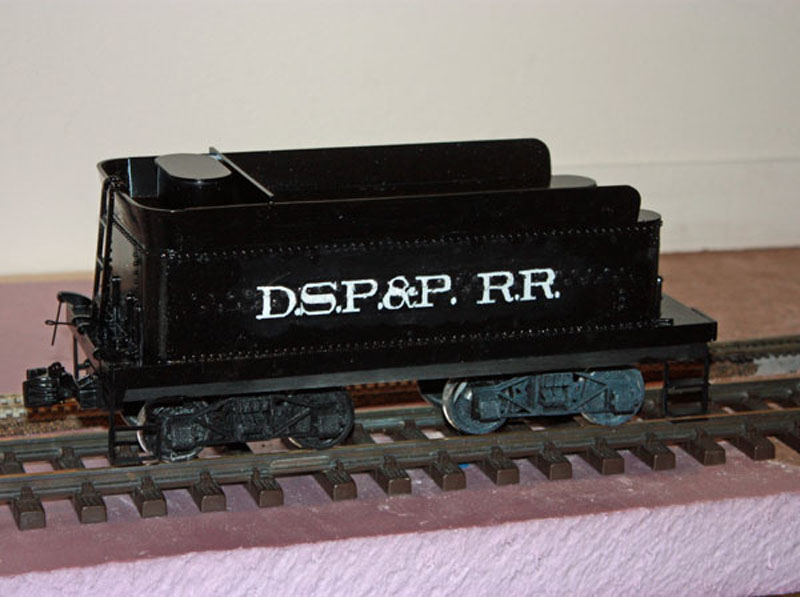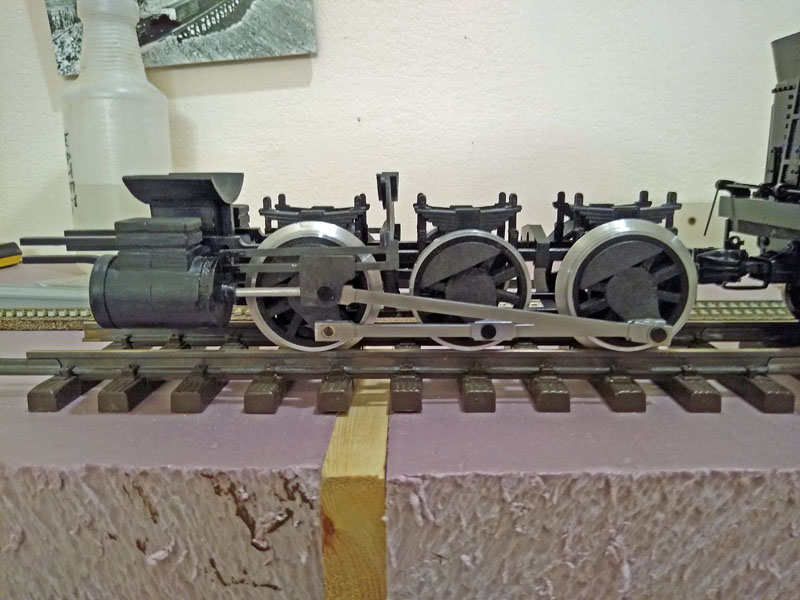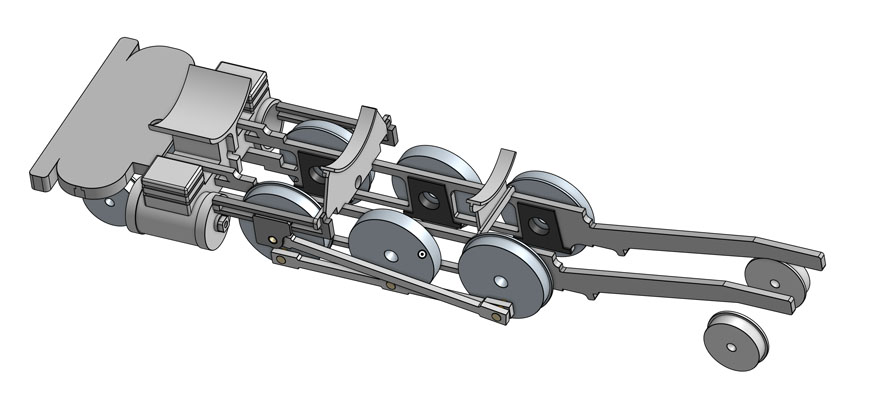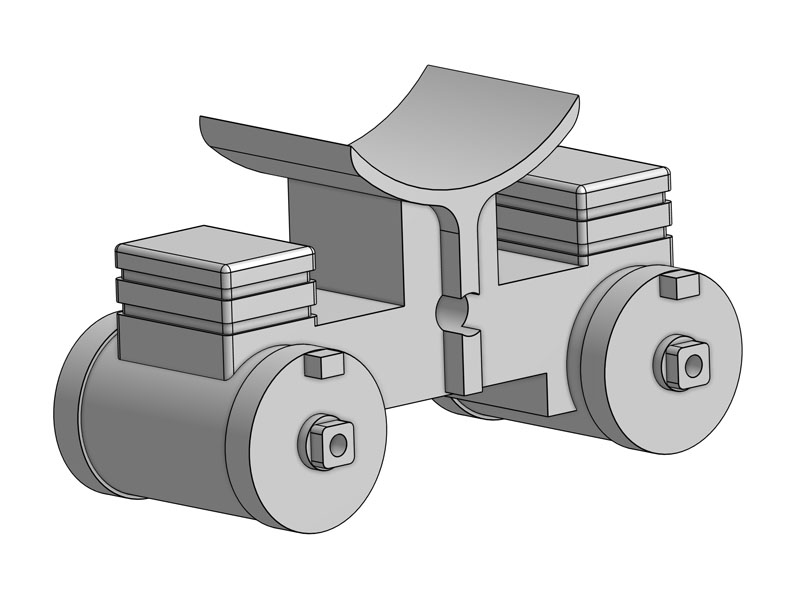Modeling and 3Dprinting
|
Since this forum has a number of fine modelers I thought I would ask for some advice on a project I am working on. A few months ago I decided to model the Baldwin 2-6-2 Prairie located in Como. Since it was my first scale model attempt, I decided to do the model in 1:20.3 scale using 3Dprinting. The tender design and fabrication went pretty smoothly (except for decals).
 The locomotive work has been somewhat problematic. Good mechanical operation requires an accuracy of better than 0.010“ which is difficult to obtain with 3Dprinting. The issue is not the printer but the ABS material I am using which distorts during the filament heating and cooling process. Good design practices and control of the printer features can eliminate or minimize shrinkage and warping but getting the accuracy needed for reliable running gear are challenging. I have gotten around some of this issue by out sourcing the moveable mechanical pieces to CNC milling and water jet cutting but this is pricey. So I am ready to restart from the beginning again.  If I continue using 3Dprinting I am considering changing my filament to PETG which supposedly is less thermally sensitive. Has anyone tried this material? Another approach might be to purchase a desktop CNC mill. Ones that can machine aluminum are pretty pricey but there are several available that should be able to machine plastic reliably. Does anyone have a recommendation on what CNC might be applicable and what type of plastic is appropriate for machining. Is a coolant required to address melting issues? This is the first time I have posted to this forum so if this isn’t the type of topic the group addresses please let me know and I will refrain from posting along these lines in the future. I did a search for "3Dprinting" but nothing came up. However if this subject is covered under a different topic title please let me know. And Merry Christmas to all! Thanks, Phil |
|
Administrator
|
Hi, Phil. This is not only interesting because it addresses a very contemporary aspect of Como's evolving history, but also involves 3D printing, something old dinosaurs like me know virtually nothing about.
All I have to offer is encouragement, and welcome to this group! Looking forward to reading comments from those who know more than I do about 3D printing. Mike |
|
This post was updated on .
In reply to this post by RedCarGo
Very cool stuff, and you clearly know your way around a CAD program. Have you considered trying a non-filament 3D printer--like the resin based SLA printers? They offer better resolution than the filament printers, but are generally pricier.
I have a Wanhao D7, which has proved more problematic than I wanted, that I got for ~$700. I've had much better results with a Formlabs resin printer at my company's Maker Garage, but the current version comes in at $3500, so a pricey home hobby item. You could also use a service like Shapeways (Shapeways.com) to print a 3D file for you --they offer filament, powder, and resin options. They also offer a marketplace where you can sell copies of your model--there are several Colorado and Southern models in Hon3 and Sn3 available in their store I've not priced their one-off printing services but they invite file uploads and indicate they will provide both feedback and quotes as to options, Steve Guty Lakeway, Texas |
|
I have a Formlabs form 2 on my desktop. I made the decision based on a previous trial of a FDM machine that I was not impressed with, and was able to return. I also model in 1:20.3, but would mot attempt to make a working locomotive frame out of any engineered plastic, it will just not stand up to the use. I would recommend that you have a frame made from at least 6061 alum. since you have a cad file made already, having a machine shop local to you quote doing the machining from your file should be reasonable. I would get a couple of quotes just to be sure you are getting a reasonable price.
I use my machine to produce detail parts that are otherwise unavailable. the largest part I have made is a passenger car end, which just fit into the print area. Al P. |
|
Al,
What kind of resolution does the Form 2 have? Much cleanup? Interested in making patterns for white metal parts in 1/48". Rich Rands Berkshire Valley Models |
|
In reply to this post by Mike Trent
Phil,
That is REALLY cool ! I look forward to seeing your progress. The Tender looks great. Btw, The prototype locomotive is "Problematic" as well ...:) Keep up the good work ! Jerry |
|
In reply to this post by Al Pomeroy
The replies so far gave me a few things to think about.
I had not considered an SLA printer and will look into those in more detail this weekend. A brief look seems to indicate the Formlabs form 2 has been replaced by the Form 3. At $3,500 this approaches the price of a good quality small CNC milling machine ($4,500) The mill can handle 6061 which is a nice capability. I failed to mention earlier that the frame and connecting rods were made by water jet cutting 10ga cold rolled steel. The drive wheel tires were cut out of 6061 on a lathe. For bearing surfaces I used commercial brass tubing. All of these metal parts are very acceptable. The other parts were FDM printed in ABS.  I ran into trouble when all the pieces were assembled. Clearances between the cross head and connecting rods and drive wheel and frame are very tight. The article that controls all of these clearances is the front saddle assembly which was 3Dprinted. In hindsight, tolerances on this part should be on the order of ±0.003”.  I think a good next approach might be to redesign the front saddle/cylinder assembly to use a core made by water jet cutting 6061 and then 3Dprinting “cosmetic” surface features. In addition I think some unprototypical redesigning of the middle and rear saddles to make them serve as frame alignment pieces would be worthwhile. Phil |
«
Return to C&Sng Discussion Forum
|
1 view|%1 views
| Free forum by Nabble | Edit this page |

